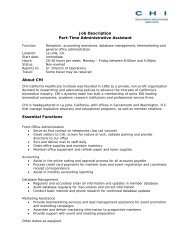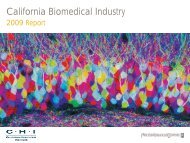California Biomedical Industry - California Healthcare Institute
California Biomedical Industry - California Healthcare Institute
California Biomedical Industry - California Healthcare Institute
Create successful ePaper yourself
Turn your PDF publications into a flip-book with our unique Google optimized e-Paper software.
Special sectionPharmaceuticals in the environment (PIE):Further study is warrantedThe SMARxT disposalcampaign: Addressing unusedpharmaceuticals simply andeffectivelyTechnological improvements haveenabled the detection of chemicals,including pharmaceuticals and overthe-counter(OTC) drugs, in aquaticenvironments and drinking water intrace quantities — less than one partper-billion.As a result, questionsare emerging over whether thesefindings are meaningful from a healthperspective.The pathway for pharmaceuticalsentering the environment is known andundisputed. Normal and appropriatepatient use and excretion is the primarysource of pharmaceuticals enteringthe domestic wastewater stream,accounting for more than 90 percentof the detected concentrations. Theremaining sources (10 percent or less)are a combination of improper disposalof unused medicines (flushing themdown a sink or toilet) and normalmanufacturing discharges.While scientists have found no adverseimpacts on human health, companies,governmental regulators, nongovernmentalorganizations, legislators,and the media have all taken note of theissue. Additional study is necessary toassess the risks posed and determinethe most effective and efficient ways toaddress the source pathways.Take-back programs will notprevent PIEDespite consensus among manyconcerned groups that improperdisposal of unused medicines is aminor contributor to PIE, a desire foraction has evolved into a movementto require drug manufactures topay for the collection and disposalof unused prescription drugs. Overthe past decade, take-back programshave emerged throughout Europeand Canada. Studies to track theconcentration of pharmaceuticals insurface waters in European countrieswith mandatory take-back programsshow the programs have resulted in nodiscernable changes in concentrationsof PIE over this period.Take-back programs are now croppingup throughout the United States. In2009, Johnson & Johnson funded astudy that evaluated the quantities andtypes of household pharmaceuticalsdisposed of in the nine counties of theSan Francisco Bay Area using currenthousehold take-back systems. Thecomprehensive evaluation confirmedthe benefit of a take-back programwould be negligible. Yet, in October2010, the Public Safety Committee ofthe San Francisco Board of Supervisorspassed the Safe Drug Disposalordinance, which, if passed by thefull Board and signed by the mayor,would mandate that pharmaceuticalcompanies participate in a take-backprogram or face financial penalties.The SMARxT DisposalCampaignThe easy, environmentally sound wayto dispose of unused medicines issimply to put them in the householdtrash. Modern landfills are veryeffective in preventing trace materialsfrom entering the environment.In March 2008, the U.S. Fish andWildlife Service, the AmericanPharmacists Association and PhRMAjoined together to promote SMARxTDisposal, a national public awarenesscampaign to educate the public aboutsafe and proper disposal methods ofpharmaceuticals and OTC medicines.The campaign recommends that allunused medicines, unless specifiedotherwise by the FDA, be disposed ofin an appropriate manner at home.More information about the SMARxTDisposal program may be found atwww.smarxtdisposal.net.“In these difficult economictimes, the last thing Americaneeds is complicated andexpensive drug take backprograms that are likely tocontribute to rising healthcarecosts.”Dr. Patrick Moore,co-founder and former leaderof Greenpeace and chair,Greenspirit Strategies Ltd.<strong>California</strong> <strong>Biomedical</strong> <strong>Industry</strong> 2011 Report | 99






